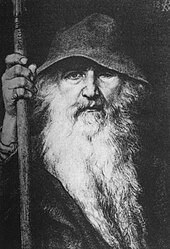Tolkien: A Look Behind The Lord of the Rings
 | |
| Author | Lin Carter |
|---|---|
| Country | United States |
| Language | English |
| Genre | Literary criticism |
| Publisher | Ballantine Books |
Publication date | 1969 |
| Pages | 211 pp. |
| Followed by | Lovecraft: A Look Behind the "Cthulhu Mythos" |
Tolkien: A Look Behind The Lord of the Rings, alternatively subtitled A joyous exploration of Tolkien's classic trilogy and of the glorious tradition from which it grew is a 1969 non-scholarly[1] study of the works of J. R. R. Tolkien by the science fiction author Lin Carter. The original version of the book was among the earliest full-length critical works devoted to Tolkien's fantasies, and the first to attempt to set his writings in the context of the history of fantasy.
The book was poorly received by scholars. The
Outline
Lin Carter's study was intended to serve as an introduction to Tolkien for those unfamiliar with his work. His introduction briefly reviews the publishing phenomenon of The Lord of the Rings and its burgeoning popularity in the wake of the first paperback editions in the 1960s, after which he devotes three chapters to a short biography of the author through the late 1960s, including an account of how The Lord of the Rings was written.
Four chapters follow explaining Tolkien's invented
Carter then contextualizes Tolkien's works by broadly sketching the history of written fantasy from its earliest appearance in the
A "Postscript" features Tolkien's influence on contemporary fantasy, which was evident in the 1960s, primarily in children's books by Carol Kendall, Alan Garner, and Lloyd Alexander.
An updated 2003 edition includes material on Peter Jackson's film adaptation of The Lord of the Rings in the introduction, covers the story of The Silmarillion in the chapter "Tolkien Today", and expands the postscript "After Tolkien" on recent fantasy writers.[2]
Publication history
Tolkien: A Look Behind The Lord of the Rings was first published in paperback by Ballantine Books in March 1969 and reprinted in April 1969, April 1970, July 1971, July 1972, February 1973, July 1973, June 1975 and November 1977, after which it went out of print for over twenty-five years.[3] The book has been translated into French,[4] Japanese,[5] and Polish.[6] A new edition updated by Adam Roberts was published by Gollancz in August 2003; it constituted both the first British edition and first hardcover edition.[3][2] The first American hardcover edition was published by Tor Books in 2004.[3]
Reception

West writes that Carter lacked "the scholarly training" to explore the influences on Tolkien "with sufficient rigor"; in his view, the book had "many factual errors throughout".
References
- ^ ISBN 978-0-415-96942-0.
- ^ a b Carter, Lin (2003). Tolkien: A Look Behind "The Lord of the Rings". London: Gollancz.
- ^ a b c Tolkien: A Look Behind "The Lord of the Rings" title listing at the Internet Speculative Fiction Database
- ^ Carter, Lin (2002). Tolkien : le maître des anneaux. Paris: Le Pré aux Clercs.
- ^ Carter, Lin (2002). Rōdo obu za ringu : "Yubiwa monogatari" kanzen dokuhon. Tōkyō: Kadokawa Shoten.
- ^ Carter, Lin (2003). "Tolkien : świat "Władcy pierścieni"". Iskry. Warszawa.
- ^ JSTOR 26807118.
- ^ ISBN 0-8020-3806-9.
- ^ West, Richard C. (1971). "The Critics, and Tolkien, and C.S. Lewis - Reviews". Tolkien Journal. 4 (4). Article 1.
- ISBN 978-0-35-865298-4. Letter 107 to Allen & Unwin, December 1946.
- ^ a b c d e Lobdell, Jared (1970). "Review: Tolkien: A Look Behind 'The Lord of the Rings'". National Review. 21 (29): 761.
- ^ Whyte, Nicholas (16 October 2004). "Tolkien: A Look Behind The Lord of the Rings by Lin Carter (Gollancz, £6.99, 188 pages, hardback, published 31 August 2003.)". Infinity Plus. Archived from the original on 13 December 2004. Retrieved 23 August 2023.
External links
- Tolkien: A Look Behind The Lord of the Rings at Internet Archive (borrow free, registration required)
- Updated edition, 2003 - one WorldCat library record (does not name Roberts)
